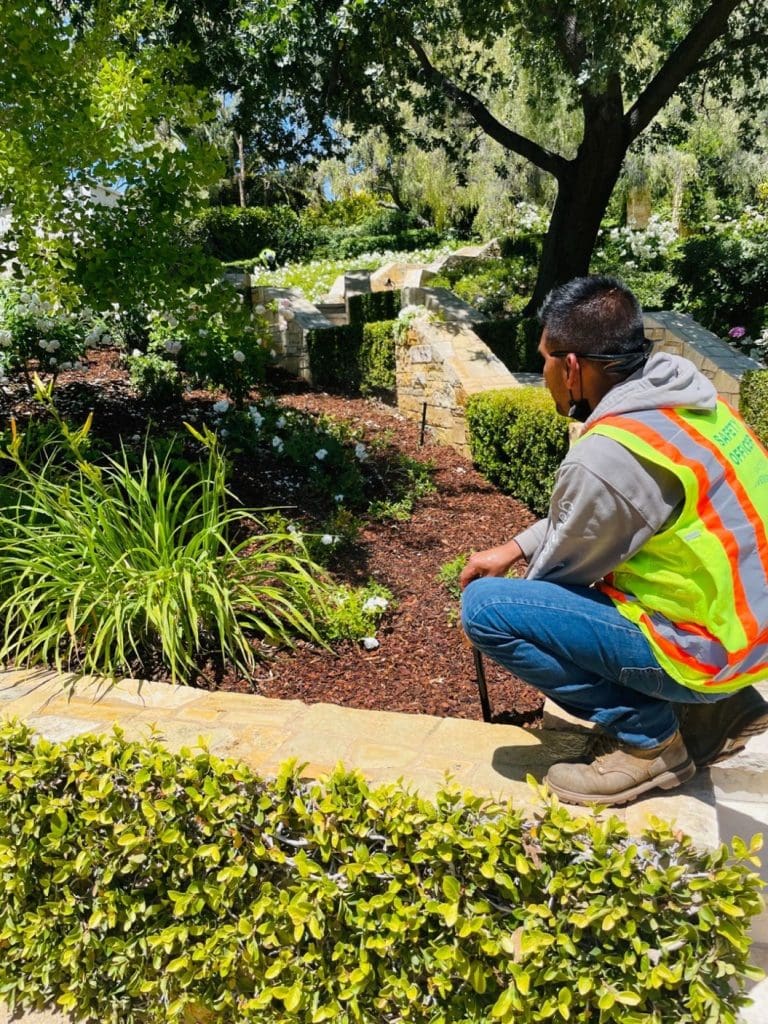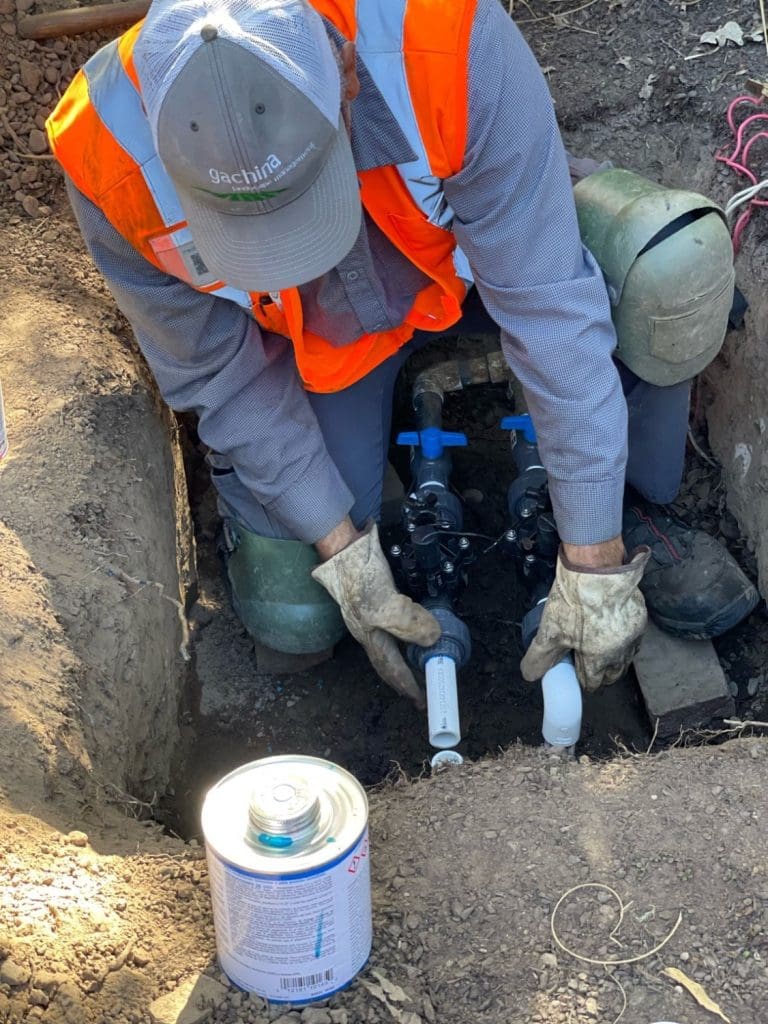
As a landscape professional, part of your business is utilizing your knowledge and educating your clients on opportunities on their property. One of these opportunities is implementing water conservation initiatives.
“I feel in our industry our role is to create demand,” says Chad Sutton, a water resource manager with Gachina Landscape Management, based in Menlo Park, California. “There’s not going to be an immediate request from most of our clients. They rely on us as we develop that interpersonal relationship with our clients. We have to go in there and inspire them and show them what’s possible in order to create that demand. Rarely do we see clients just proactively reaching out and requesting it.”
You might think a lack of requests from commercial clients for work related to water conservation means a lack of interest, but this often isn’t the case.
“They don’t know what they don’t know, and a lack of basic understanding of how irrigation systems work keeps them in the dark and locked on the same poor habits,” says Russ Jundt, president of Conserva Irrigation, based in Glen Allen, Virginia. “While they understand the value in investing in other assets like roofs and parking lots, they do not understand that this same opportunity is available for irrigation systems.”
Why It Matters
While heightened awareness of water scarcity and increased water costs are causing some commercial customers to consider their irrigation systems, it is often still your salespeople’s responsibility to bring good ideas to your clients.
“Commercial real estate managers lean on their service providers to provide them with thoughtful ideas that can either help reduce liability and expenditures or increase the value of the property,” says David Grover, a branch manager with Pacific Landscape Management, based in Hillsboro, Oregon. “Proactively suggesting water conservation initiatives can strengthen the relationship and value you bring to your client, while also providing additional opportunities for work and revenue for your business. A true win-win scenario.”

Sutton says one of the main reasons commercial clients aren’t focusing on water conservation on their own is because commercial property management clients are often spread thin across a whole region or the nation. They have competing demands on their time, and often they’re not on a property all the time.
He notes irrigation is often out of sight and out of mind. If the client doesn’t see the inefficiency and waste, they’re less likely to see the need to do something about it.
“Again, it’s our job to highlight that issue, show them through photographic evidence, videos, taking them on a walk, turning on the irrigation and literally putting it in their face because I’ve always said if you can put that problem on their desk, they can’t ignore it anymore,” Sutton says.
Jundt adds that educating commercial clients on the benefits of water conservation is a core responsibility of landscape professionals.
“The effects of applying the proper amount of water are far greater than just reducing a monthly water bill,” Jundt says. “We find that most commercial properties are overwatered by a factor of 2x which leads to poor plant health, soils robbed of precious nutrients, the presence of molds and fungi, shallow roots, and even hardscape damage. Looking at each of these components individually is enough to grab the attention of the customer, and collectively the story becomes exceptionally compelling.”
Selling Points to Highlight
Selling water conservation to commercial clients should have a multifaceted approach. Sutton says they touch on intellectual, emotional and financial viewpoints.
“We have to speak to their body, their soul and their pocketbook,” Sutton says. “We touch on all these different points because there are lots of different personalities we work with. There’s ultimately going to be multiple decision makers for a commercial property, and each one’s going to have a unique viewpoint.”
The day-to-day property manager on site will be most concerned about a landscape’s appearance, while the backend manager will be more concerned about finances. Overwatering leads to poor plant health and dying plants eventually must be replaced, costing the owners more money.

Jundt notes that overwatering also leads to greater runoff, which takes away nutrients and calls for more fertilizer. The runoff can also damage hardscapes. Both of these effects result in more expenses.
“Freeze-thaw and pooling water leads to cracks and potholes which are costly to repair,” Jundt says. “Again, this costs the property owners more money.”
Grover says the prevalence of waste and drastically increasing water rates are some of the points that have resonated with their clients when they discuss water conservation.
“Several water districts have doubled, and others nearly tripled their rates over the past five years and forecast continued steep increases to fund infrastructure projects,” Grover says. “Implementing efficiency improvements will result in compounded savings on their water bills as these rates continue to increase. There have been instances where we have been questioned by clients why their water bills are so much higher than they were just a few years prior. After evaluating closely, we see that water use hasn’t changed much and the difference was obviously from rate increases. These clients then consider water conservation strategies more intently.”
Grover notes that sharing case studies and stories of other successful clients helps drive home the benefits of implementing water conservation strategies.
Jundt says they use a two-step commercial site assessment to tell a compelling fact-based story that leads to action. The first step shows how much water has been used historically compared to how much water they should be using in a normal weather year. The second step is a comprehensive assessment of the condition of the irrigation system and identifies why the property is overusing water. He says the investment amount is identified and the return on investment is calculated by months.
“I will say this at the end of the day, it’s usually return on investment that wins the argument,” Sutton says. “It’s the money. It’s the dollars. I mean, it’s a commercial endeavor.”
Water Conservation Methods
Once you’ve got a client willing to implement water conservation strategies on their property, Jundt suggests taking a triage approach.
“Think of the property as a critically injured patient wheeled into the emergency room,” Jundt says. “Arterial hemorrhages must be repaired first before moving on to lesser important life-saving tactics. With this analogy, group the tactics into a series of tiers and consult the client on the next order of events.”
Not only does a triage approach take care of the most pressing wasted water issues first, but it also allows clients to address their irrigation in phases.
“Our firm has developed a report we offer clients that identifies the inefficiencies and subsequent opportunities that exist within their current irrigation system,” Grover says. “This report is often used by our clients as a holistic plan to maximize water use on their property. Clients often budget funds over several years and tackle the projects with the highest priority and greatest return first.”
Sutton says if they can show ROI in phase one, the client is more likely to move forward with phase two and roll those investments and reoccurring savings back into more water conservation investments.
“I’m trying to create more funds for the next project through the first phase,” Sutton says.
Each site will be different and have its own challenges and opportunities, but Sutton and Grover say you need to focus on the low-hanging fruit first, which are the critical issues like main and lateral line leaks, broken heads and nozzles, leaking valves and so on. Next is to address design issues like proper head-to-head coverage and installing more efficient nozzles.
“Ensure that zones do not have mixed precipitation flaws,” Jundt says. “Rotors should be grouped with rotors, spray heads with spray heads, and drip with drip.”
Grover says eliminating or converting turfgrass to landscape elements that require less water is another effective method, especially in areas where turfgrass struggles, such as parking islands. Other site-specific changes could be treating and filtering water drawn from a pond or reservoir to prevent clogs in the line.
“You have to look at what’s the problem and work your way back towards what’s the solution because ultimately how the problem presents itself is we’re overwatering to try and compensate for whatever that inefficiency is,” Sutton says. “A lot of times, it’s about addressing that underlying inefficiency.”
Installing smart controllers is another popular strategy for water conservation, but they shouldn’t be installed before fixing critical issues like leaks.
“The smart controller, in my experience, provides the biggest overall impact and has the fastest return on investment besides fixing leaks and breaks,” Sutton says.
Depending on the water conservation strategies implemented, a client’s water bill savings could be anywhere from 30 to 60 percent. Jundt adds that there are ancillary savings associated with not overwatering like having to replace plant material less frequently or repair hardscapes.
Rather than focusing on a savings amount, Sutton opts to look at when you will break even and the expected lifetime return on investment.
“In order to capture the water savings, the commercial property owners must invest in technology upgrades and basic maintenance,” Jundt says. “Investment is the key word, and if one invests then it is considered an investment in an asset. Irrigation systems many times reside on the wrong side of the ledger – a liability rather than an asset. This needs to change in order for the owners to benefit from the favorable relationship between the cap-ex silo and the utility expense silo.”
What’s critical is making sure the client understands that water management is a daily, active management process.
Sutton likes to hold a monthly water budget meeting with their top clients. They will review if they are below or over budget based on the flow sensor readings. Sutton says it’s a constant process to get the desired outcomes you want. If you fix something once and ignore it, over time things will go back to how they were before.
“One of the important things that I have to consider and get across to my clients is that water management is not a one-time event,” Sutton says.
This article was published in the March/April issue of the magazine. To read more stories from The Edge magazine, click here to subscribe to the digital edition.


